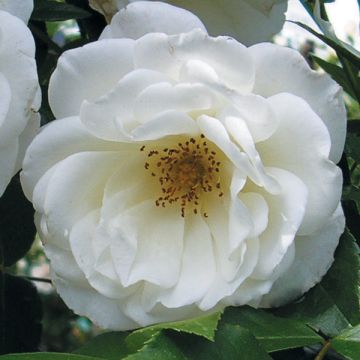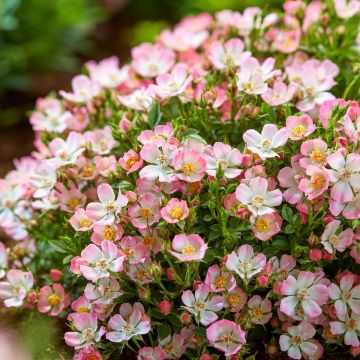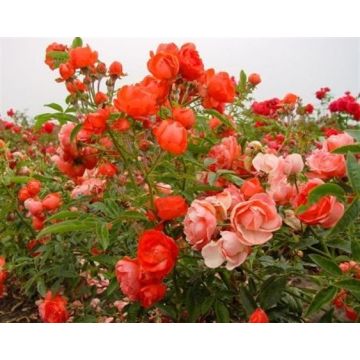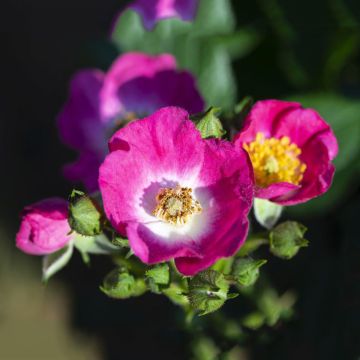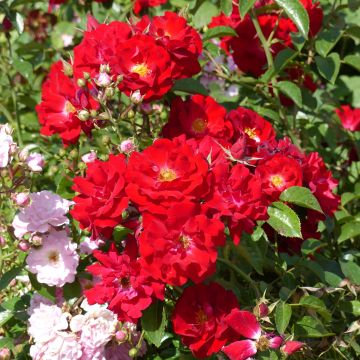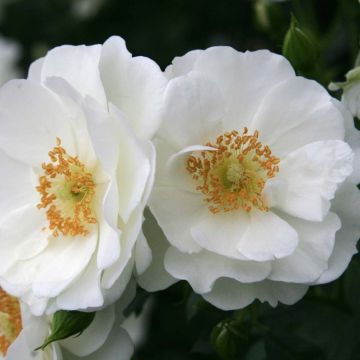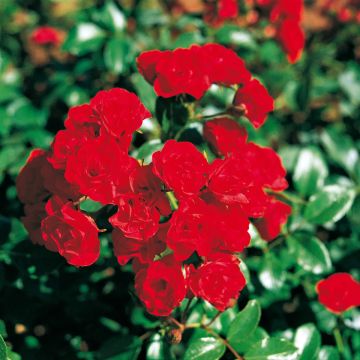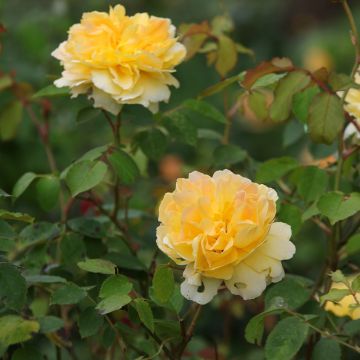

Rosa x polyantha Bluesette - Dwarf Rose
Rosa x polyantha Bluesette - Dwarf Rose
Rosa x polyantha Bluesette
Rose
Why not try an alternative variety in stock?
View all →This plant carries a 24 months recovery warranty
More information
We guarantee the quality of our plants for a full growing cycle, and will replace at our expense any plant that fails to recover under normal climatic and planting conditions.
From €5.90 for pickup delivery and €6.90 for home delivery
Express home delivery from €8.90.
From €5.90 for pickup delivery and €6.90 for home delivery
Express home delivery from €8.90.
Does this plant fit my garden?
Set up your Plantfit profile →
Description
The Rose bush or Rosa 'Bluesette' is an adorable variety of miniature rose bush with lovely small, very double flowers, beautifully formed, and flat, with a beautiful star-shaped architecture. Slightly fragrant, they are of an elegant mauve-lilac colour. Upright in habit, very compact and well-branched, repeat flowering, it develops lush fresh green foliage and is covered in flowers from June to October. This variety is splendid in a small bed, as a border or in a pot and composes long-lasting bouquets.
The 'Bluesette' Rose is a creation by L. Lens dating back to 1984 and pays tribute to a composition by harmonica player Toots Thielemans of the same name. It is derived, among other things, from the x polyantha rose bush, a very floriferous bush rose that produces flowers grouped in bouquets. The shrub rose shows a bushy and upright habit, a little taller than wide and reaches approximately 45 cm (18in) in height and 55 cm (22in) in width at maturity. Its leaves are divided into elliptical leaflets of a pale to medium green. Flowering begins in June. It continues continuously throughout summer and until autumn, in October, if faded bouquets are cut as they appear. The very double flowers measure 5 cm (2in) in diameter. They have a flat, star-shaped form. Their colour is a very unique mauve-lilac pink. The hardiness of this rose bush is excellent, down to at least -15 °C (5°F).
The 'Bluesette' Rose bush should be planted in fertile, moist and well-drained soil, in full sun. It works wonders as a border, in a bed, or in a pot. Pair it with low-growing groundcover roses (Maman Turbat, The Fairy). In a perennial bed, it can be combined with perennial geraniums (Geranium Blue Cloud, Anne Folkard, Nimbus, Orion), catmints, snapdragons, foxgloves, or other perennial salvias, as long as low-growing varieties are chosen. It pairs perfectly with bush roses with pink or white flowers in a romantic garden. In a pot, the beautiful shape of its flowers and its beautiful colour are enough on their own.
Report an error about the product description
Plant habit
Flowering
Foliage
Botanical data
Rosa
x polyantha
Bluesette
Rosaceae
Rose
Cultivar or hybrid
Other Dwarf and mini Roses
Planting and care
Rose bushes prefer a sunny location (at least 4 to 5 hours of sun per day) but sheltered from the burning rays of midday and strong winds. They appreciate loose, permeable and rich soils. They will adapt to any garden as long as the soil is well worked and sufficiently rich. To plant your rose bush, work your soil to a depth of 25 cm (10in), crumble the soil well and place a bottom dressing such as bonemeal in the planting hole. Position your plant, removed from its pot, covering the top of the root ball with 3 cm (1in) of soil, fill in and water generously to eliminate air pockets. In dry weather, regular watering for a few weeks is necessary to facilitate root growth. Also remember to provide your rose bush with special rose fertilizer to stimulate flowering of the plants.
Rose bushes are often spotted or unsightly at the end of summer, but this is not a problem for their development. These spots are not harmful to the rose bush, it is a natural phenomenon.
Planting period
Intended location
Care
This item has not been reviewed yet - be the first to leave a review about it.
Roses by purpose
Haven't found what you were looking for?
Hardiness is the lowest winter temperature a plant can endure without suffering serious damage or even dying. However, hardiness is affected by location (a sheltered area, such as a patio), protection (winter cover) and soil type (hardiness is improved by well-drained soil).

Photo Sharing Terms & Conditions
In order to encourage gardeners to interact and share their experiences, Promesse de fleurs offers various media enabling content to be uploaded onto its Site - in particular via the ‘Photo sharing’ module.
The User agrees to refrain from:
- Posting any content that is illegal, prejudicial, insulting, racist, inciteful to hatred, revisionist, contrary to public decency, that infringes on privacy or on the privacy rights of third parties, in particular the publicity rights of persons and goods, intellectual property rights, or the right to privacy.
- Submitting content on behalf of a third party;
- Impersonate the identity of a third party and/or publish any personal information about a third party;
In general, the User undertakes to refrain from any unethical behaviour.
All Content (in particular text, comments, files, images, photos, videos, creative works, etc.), which may be subject to property or intellectual property rights, image or other private rights, shall remain the property of the User, subject to the limited rights granted by the terms of the licence granted by Promesse de fleurs as stated below. Users are at liberty to publish or not to publish such Content on the Site, notably via the ‘Photo Sharing’ facility, and accept that this Content shall be made public and freely accessible, notably on the Internet.
Users further acknowledge, undertake to have ,and guarantee that they hold all necessary rights and permissions to publish such material on the Site, in particular with regard to the legislation in force pertaining to any privacy, property, intellectual property, image, or contractual rights, or rights of any other nature. By publishing such Content on the Site, Users acknowledge accepting full liability as publishers of the Content within the meaning of the law, and grant Promesse de fleurs, free of charge, an inclusive, worldwide licence for the said Content for the entire duration of its publication, including all reproduction, representation, up/downloading, displaying, performing, transmission, and storage rights.
Users also grant permission for their name to be linked to the Content and accept that this link may not always be made available.
By engaging in posting material, Users consent to their Content becoming automatically accessible on the Internet, in particular on other sites and/or blogs and/or web pages of the Promesse de fleurs site, including in particular social pages and the Promesse de fleurs catalogue.
Users may secure the removal of entrusted content free of charge by issuing a simple request via our contact form.
The flowering period indicated on our website applies to countries and regions located in USDA zone 8 (France, the United Kingdom, Ireland, the Netherlands, etc.)
It will vary according to where you live:
- In zones 9 to 10 (Italy, Spain, Greece, etc.), flowering will occur about 2 to 4 weeks earlier.
- In zones 6 to 7 (Germany, Poland, Slovenia, and lower mountainous regions), flowering will be delayed by 2 to 3 weeks.
- In zone 5 (Central Europe, Scandinavia), blooming will be delayed by 3 to 5 weeks.
In temperate climates, pruning of spring-flowering shrubs (forsythia, spireas, etc.) should be done just after flowering.
Pruning of summer-flowering shrubs (Indian Lilac, Perovskia, etc.) can be done in winter or spring.
In cold regions as well as with frost-sensitive plants, avoid pruning too early when severe frosts may still occur.
The planting period indicated on our website applies to countries and regions located in USDA zone 8 (France, United Kingdom, Ireland, Netherlands).
It will vary according to where you live:
- In Mediterranean zones (Marseille, Madrid, Milan, etc.), autumn and winter are the best planting periods.
- In continental zones (Strasbourg, Munich, Vienna, etc.), delay planting by 2 to 3 weeks in spring and bring it forward by 2 to 4 weeks in autumn.
- In mountainous regions (the Alps, Pyrenees, Carpathians, etc.), it is best to plant in late spring (May-June) or late summer (August-September).
The harvesting period indicated on our website applies to countries and regions in USDA zone 8 (France, England, Ireland, the Netherlands).
In colder areas (Scandinavia, Poland, Austria...) fruit and vegetable harvests are likely to be delayed by 3-4 weeks.
In warmer areas (Italy, Spain, Greece, etc.), harvesting will probably take place earlier, depending on weather conditions.
The sowing periods indicated on our website apply to countries and regions within USDA Zone 8 (France, UK, Ireland, Netherlands).
In colder areas (Scandinavia, Poland, Austria...), delay any outdoor sowing by 3-4 weeks, or sow under glass.
In warmer climes (Italy, Spain, Greece, etc.), bring outdoor sowing forward by a few weeks.










































